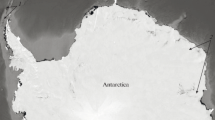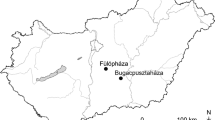Summary
CO2 exchange was measured in three cryptoendolithic lichen samples from the ice-free mountains of Southern Victoria Land. Optimum temperature for net photosynthesis at different light intensities ranged from below 2°C to about 7°C; the upper compensation point ranged from 5°C to 15.7°C, and the lower compensation point could be estimated in two samples as being between-6°C and-8°C. Dark respiration rates were higher than those of net photosynthesis. The results indicate that these cryptoendolithic lichens are not more adapted to low temperatures than are crustose lichens from coastal Antarctica. Calculations show that optimum temperatures for photosynthesis may not be reached in the natural environment. Photosynthetic rates were low, but they increased when samples were split into smaller pieces, permitting gas exchange through broken rock surfaces. In nature, when gas exchange is possible only through the intact rock crust, these apparent rates are probably even lower.
Similar content being viewed by others
References
Arnon DJ (1949) Copper enzymes in isolated chloroplasts. Phosphoenoloxidase in Beta vulgaris. Plant Physiol 24:1–15
Brown DH (1980) Notes on the instability of extracted chlorophyll and a reported effect of ozone on lichen algae. Lichenologist 12:151–154
de Nicola GM, Tomaselli R (1961) Richerche preliminari sui pigmenti nel ficosimbionte lichenico Trebouxia decolorans AHM. II. Clorofille. Ist Bot Univ Catania 2:29–34
Friedmann EI (1978) Microorganisms in Arctic desert rocks from dry valleys and Dufek Massif. Antarc J US 12:26–30
Friedmann EI (1978) Melting snow in the dry valleys is a source of water for endolithic mircoorganisms. Antarc J US 13:162–163
Friedmann EI (1980) Endolithic microbial life in hot and cold deserts. Origins Life 10:233–245
Friedmann EI (1982) Endolithic microorganisms in the Antarctic cold desert. Science 21:1045–1053
Friedmann EI, Ocampo R (1976) Endolithic blue-green algae in the dry valleys. Primary producers in the Antarctic desert ecosystem. Science 193:1247–1249
Friedmann EI, Garty Y, Kappen L (1980a) Fertile stages of endolithic lichens in the dry valleys. Antarct J US 15:166–167
Friedmann EI, LaRock PA, Brunson JD (1980b) ATP, chlorophyll and organic nitrogen in endolithic microbial communities and adjacent soils in the dry valleys of Southern Victoria Land. Antarct J US 15:164–166
Friedmann EI, Friedmann RO, McKay CP (1982) Adaptations of cryptoendolithic lichens in the Antarctic desert. In: Jouventin P, Massé L, Tréhen P (eds) Colloque sur les écosystemes subantarctiques. Comité National Français des Recherches Antarctiques, Paris, pp 65–70
Golubic S, Friedmann I, Schneider J (1980) The lithobionthic ecological niche, with special reference to microorganisms. J Sediment Petrol 51:475–478
Kappen L (1973) Response to extreme environments. In: Ahmadjian V, Hale MA (eds) The lichens. Academic Press, New York London, pp 311–380
Kappen L, Friedmann EI, Garty Y (1981) Ecophysiology of lichens in the Dry Valleys of Southern Victoria Land, Antarctica. I. Microclimate of the cryptoendolithic lichen habitat. Flora (Jena) 171:236–265
Kärenlampi L (1970) Distribution of chlorophyll in the lichen Cladonia alpestris. Rep Kevo Subarct Res Stat 7:1–8
Lange OL (1965) Der CO2-Gaswechsel von Flechten bei tiefen Temperaturen. Planta 64:1–19
Lange OL (1969) Experimentell-ökologische Untersuchungen an Flechten der Negev-Wüste. I. CO2-Gaswechsel von Ramalina maciformis (Del.) Bory unter kontrollierten Bedingungen im Laboratorium. Flora (Jena) 158:324–359
Lange OL (1980) Moisture content and CO2 exchange of lichens. I. Influence of temperature on moisture-dependent net photosynthesis and dark respiration in Ramalina maciformis. Oecologia (Berlin) 45:82–87
Lange OL, Kappen L (1972) Photosynthesis of lichens from Antarctica. Antarct Res Ser 20:83–95
Lange OL, Schulze E-D, Koch W (1970) Experimentell-ökologische Untersuchungen an Flechten der Negev-Wüste. III. CO2-Gaswechsel und Wassergehalt von Krusten- und Blattflechten am natürlichen Standort während der sommerlichen Trockenperiode. Flora (Jena) 159:525–528
Rundel PW (1972) CO2 exchange in ecological races of Cladonia subtenuis. Photosynthetica 6:13–17
Steubing L (1965) Pflanzenökologisches Praktikum. Parey, Berlin Hamburg
Stocker O (1927) Physiologische und ökologische Untersuchungen an Laub- und Strauchflechten. Ein Beitrag zur experimentellen Ökologie und Geographie der Flechten. Flora (Jena) 121:334–415
Wilhelmsen JB (1959) Chlorophylls in the lichens Peltigera, Parmelia and Xanthoria. Bot. Tidsskr 55:30–36
Author information
Authors and Affiliations
Rights and permissions
About this article
Cite this article
Kappen, L., Friedmann, E.I. Ecophysiology of lichens in the dry valleys of Southern Victoria Land, Antarctica. Polar Biol 1, 227–232 (1983). https://doi.org/10.1007/BF00443193
Received:
Accepted:
Issue Date:
DOI: https://doi.org/10.1007/BF00443193




